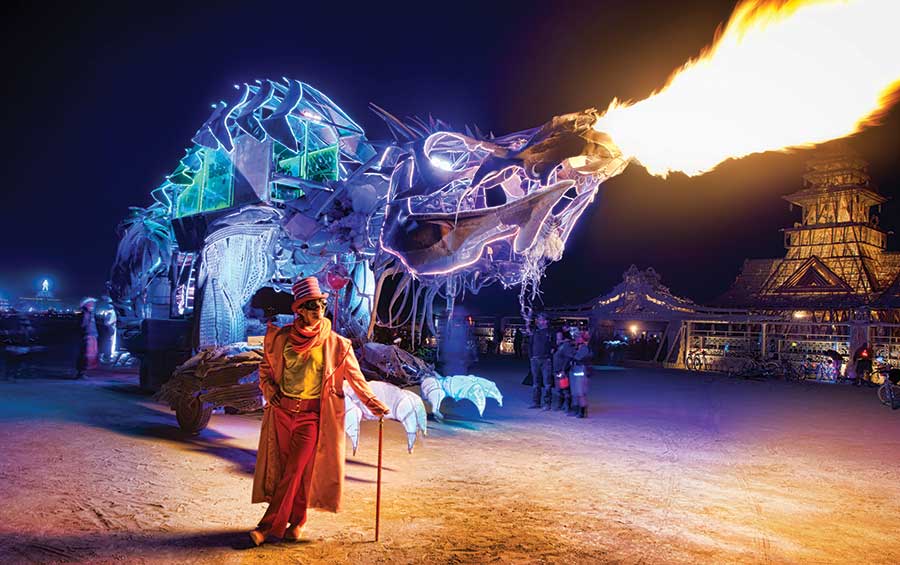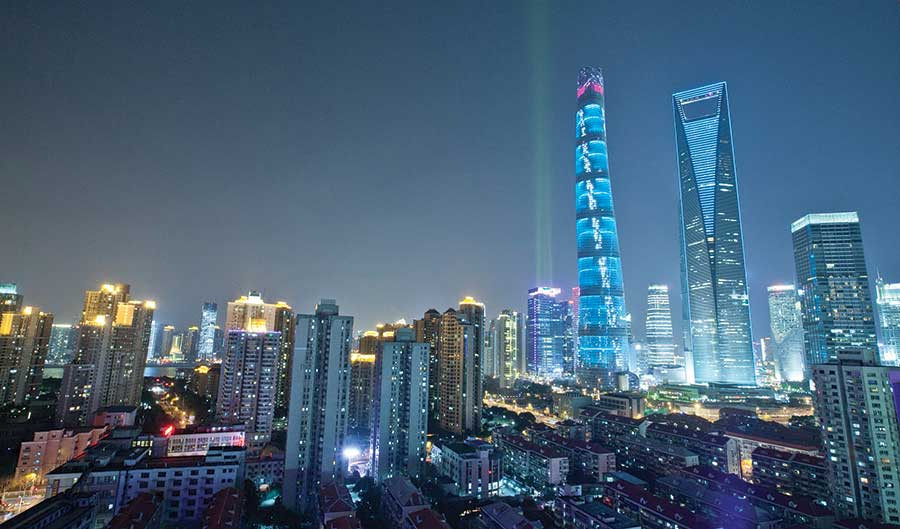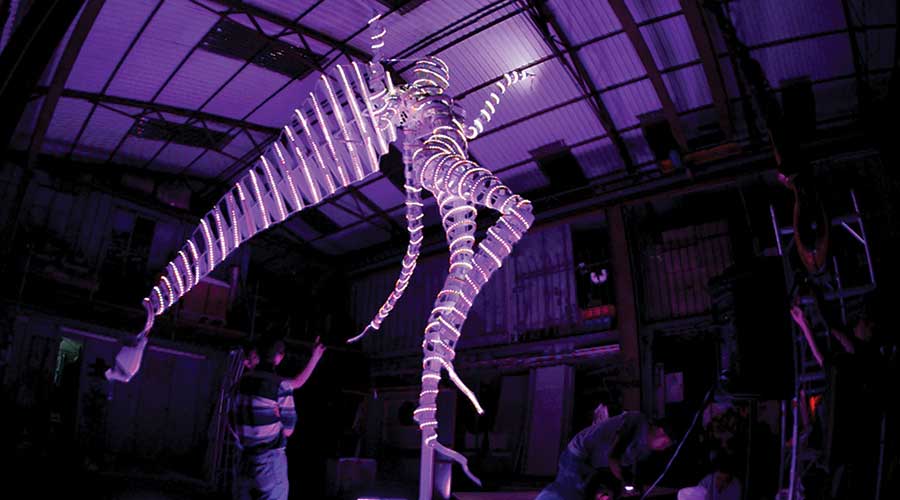Lighting designer Mike Brannon sits down with Teddy Lo – founder of LED ARTIST and Teddy Lo Studio – to discuss lighting as art, chroma therapy, Burning Man, and the on-going Victoria Harbour Spectrum project in Hong Kong.
[dropcap style=”letter” size=”52″ bg_color=”#e56b62″ txt_color=”#000000″]W[/dropcap]ith an early appreciation for the work of French Impressionist Claude Monet, Hong Kong artist Teddy Lo traveled to the U.S. to attend the renowned art school ACCD in California, earning a degree in advertising and fine art.

While a visit to a lighting factory sparked a curiosity about LED as a medium before he graduated, Lo’s first job was in advertising in New York City. While there, he continued his interest in fine art and held his first art exhibition at the Arturo Di Modica Gallery and began working on commercial lighting projects. Eventually he left the advertising world and concentrated on lighting, achieving a master’s degree in lighting design from Queensland University of Technology and founding his own light art design company LED ARTIST and Teddy Lo Studio with offices in New York City, Hong Kong, and Shanghai.
An interactive experience artist, Lo integrates selective elements of chroma-therapy (healing via color and light therapy, aligning circadian rhythms, and environmental enhancement) into his illuminated art.
He works on projects all over the world. From Burning Man events in the Nevada desert to projects spanning 50 interconnected buildings in Hong Kong’s Victoria Harbor, no exploration of light installation seems to be too challenging for Lo.
Mike Brannon: Do you create with a green design/sustainable aesthetic in mind regarding techniques and materials?
Teddy Lo: My process and production are still quite heavily based on computer software and machinery, but I have been improving on engineering and electronic techniques that would make our lighting works most energy-efficient in design.
Materials-wise, I have been interested in more permanent materials like rock and metal; however, I have been researching and testing environmental and sustainable materials such as recycled glass, plastic bottles, and various paper stocks with my brothers’ environmental lifestyle company Ecols to expand the green revolution and consciousness to my audiences.

MB: Regarding large-scale works, such as the Dragon built for Burning Man, how do you go about designing and building these types of projects?
TL: For the light dragon – Gon Kirin – I had this vision to bring an electronic beast to the playa grounds of Burning Man, so I researched and had some veteran burners introduce me to a Detroit metal art artist named Ryan Doyle. We collaborated and brainstormed taking a 20-foot, airport-style transport vehicle to a 60′-long x 12′ wide x 22′ high hydraulic and fire-breathing beast.
For me, the aesthetics and art direction is utterly important for the authenticity of experience for a Mad Max high-tech beast from another world. I had to keep the original intent of my lighting concept for the dragon while Ryan had the freedom to flaunt his skills and helped build the mechanical parts.
The dragon is still continuously evolving and now I’m working with another talented metal and mechanical artist, Henry Chang, and Playaworks in Las Vegas for the latest version of the dragon.
For other bigger projects, I tend to create the concept and designs first and then search for the best fabricator – based on the budget and criteria – to assist in large-scale manufacturing and production. Electronics-wise, we can mostly do custom finish designs in-house and source the rest from our best suppliers and vendors.
MB: You did Burning Man twice with the Dragon, how was it received?
TL: GKR received 13 blue ribbons at Makers Faire so I believe GKR embodies the excellence in art-making. It was very well-received at the Black Rock City event, as many people came up to us with awe and tremendous praises. That was a great response as there are many other creative and impressive art cars and installations throughout the event.
On a personal level, I learned a lot from these collaborations about creativity, budgeting, and management on large-scale and international art projects. It also gave me a boost in confidence in making this kind of work and realizing what kind of industrial design details one needs for public, mobile art with pyro, audio, and LED interacting lighting capabilities. It is an absolutely tricky feat, as it required dedication and diligent project management to maintain one big art float.

MB: What have been your most challenging projects?
TL: My current project – Victoria Harbour Spectrum – is one of the most challenging ones since the art concept is to evolve and replace the current nightly light show “Symphony of Light” in Hong Kong that involves over 50 buildings around the harbor. My goal is to create the largest digital canvas in the world with real-time synchronization and interactive control with art direction. Besides the technical requirements, there are many tiers of social fabric to realize this project (i.e. the Government, the Hong Kong tourism board, the general public, and real estate owners).
What makes it extra hard is that because it is my own art project, there is no funding. Therefore, we have been looking for sponsors and local public funding to bring this vision to the public and eventually to reality. We launched its first public viewing at Police Married Quarters (PMQ), which was well-received by the government agencies and general public. It was our first step to show to the world.
MB: How do your ideas and inspirations come to you?
TL: Everywhere — it also comes from a lot of reading and research, thus it requires a strong sense of curiosity. It really depends on the creative questions that you set for yourself.
MB: Who has inspired you?
TL: Claude Monet, for his eye-opening depiction of lights through his Impressionist paintings, Leo Villareal for his inspiring Artificial Intelligence-like game-of-life programming on LEDs, Zaha Hadid for her out-of-this-world spatial and sculptural design concepts, Issey Miyaki for his relentless pursuit of fabric minimalism and abstractism, and Cai Guo-Qiang for his mastery of techniques and applications of fireworks powders in performance and fine arts-making.
MB: Can you discuss your techniques and materials?
TL: There are three focuses and on-going development in my current works: sculptural design, spectrum manipulation, and interactive dynamics. The art director in me always urges me to find the best and most relevant creative concept possible before developing the artistic direction for the work. The techniques and materials are heavily based on the concept, the brief, and budget. My work emphasizes and challenges the norm and intricacies in visual, scientific, and spiritual realms through the use of luminous and contemporary technologies. I always push the envelope technically as I believe there is enough parity and mundane works out in the world that true innovation and creativity are what is needed for inspiration and sets us apart from the norm.
I do some of the programming, but my colleagues assist me as well since usually it’s a mix or combination of different programs and languages. Their computer science background helps and inspires me in more efficient ways of executing it.
MB: Do you use 3D printing for lighting design?
TL: I started using 3D printing in my last project, “Seven Keys” and I have printed 7 lamp fixtures based on the Platonic solid shapes with sacred geometry patterns. I truly see the endless possibilities and capabilities of 3D printing and I hope to keep exploring its limits in my art-making in the near future.
MB: What are you trying to say with the psychology of your designs?
TL: I am trying to bring the futuristic light and media vision into my work so each work is more intelligent, interactive, immersive, or informational to improve our experience with the medium. Psychology would be giving true meaning and function in light and color, to various spectrum, to be precise.
MB: What is “persistence of vision” for you?
TL: Persistence of Vision (POV) is an optical illusion that the brain compiles of broken visual data through the human visual system and constructs into a complete or moving image.
I have researched and designed a series of artwork based on POV. The work is a rapid scanning of digital images on a single strip of LED, and the audience perceives the full image with slight head or eye movements. A 2D POV effect is created with the linear pixel scanning combined with human visual system movements.
MB: What are some of your future projects?
TL: The Victoria Habour Spektrum (VHS) – Metatron Allure is a large linear line sculpture that I am completing to gauge and explore mass group interactivity with a 21st Century divine sculpture with the latest technology. The artwork is not out yet so I will hold off and disclose more information at the later time. (You can actually see it on my Web site though.) Seven Keys is a remake of the ancient color chambers with current technologies. It is a research project that we are pursuing to blend technologies with holistic healing through our five senses. It is a collaboration with other artists and healers. My responsibility in this project is exploring Chroma-therapy with LED technology and the dynamics of sacred geometry. The research has been tremendously sublime as the craft of light therapy and geometry goes back thousands of years. It has truly been eye opening and we are only at the tip of the iceberg, even after years of planning.
We just had the first exhibition at the K11 Art Mall in Hong Kong. It was also part of the 2015 UNESCO’s International Year of Light event and we are planning to bring it to other parts of the world for greater healing impact in the world.





